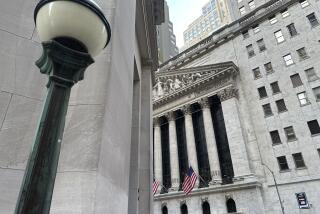Interest Rates--the Long and the Short of It
- Share via
Short- and long-term interest rates suddenly are diverging in dramatic fashion, presenting investors with a virtual embarrassment of riches.
On the one hand, a renewed jump in short rates is making money market funds, Treasury bills and bank CDs more appealing than at any time since early 1991.
At the same time, long-term bond yields have begun to tumble, ending--at least temporarily--the erosion of bond holders’ principal, and forcing some investors to consider whether it’s time to lock in long-term rates.
The fixed-income markets’ split personality has been developing for the past two weeks, but it may have become apparent to many investors only on Friday, after the government released the November employment report.
News that the economy created 350,000 new jobs in November--far above most experts’ estimates--sent short-term interest rates rocketing on the assumption that the Federal Reserve Board will have to raise short rates yet again to restrain the economy.
The yield on one-year Treasury bills leaped from 6.93% on Thursday to 6.99% on Friday, the highest in nearly four years.
As a measure of how quickly that yield has risen just in the last few weeks, consider that a buyer of a one-year T-bill on Nov. 22 got a yield of 6.58%, or 0.41-point less than Friday’s yield.
Meanwhile, longer-term bond yields had the opposite response to Friday’s employment report. Despite the clear indications of economic strength and the implied probability of another Fed hike in short-term rates in the near future, long rates actually fell.
The yield on 30-year Treasury bonds slumped to 7.90% Friday from 8.01% Thursday, and now is well below its recent peak of 8.13% reached Nov. 17. The five-year T-note yield fell to 7.71% Friday from 7.81% Thursday.
As most bond investors are painfully aware, long-term yields had been rising almost nonstop in tandem with short yields this year as the Federal Reserve tightened credit six times--most recently on Nov. 15.
So why are long yields now declining, even in the face of continued robust economic growth?
Some Wall Streeters pointed Friday to elements of the November employment report that suggest there still isn’t much upward pressure on wages--and thus inflation remains under control--despite the economy’s boom.
A big increase in wages, so the theory goes, would guarantee a new upward spiral in prices of goods and services, simply because consumers would have more to spend and thus would be willing to pay more for what they really wanted.
But even as the unemployment rate drops and workers become harder to find in some areas of the country, employers overall aren’t raising wages much. Wage inflation has been running between 2.5% and 3%, annualized, for most of this year, not much above the increase in 1993.
All year, one argument used by the bond market to justify higher long yields was that higher inflation was “just around the corner,” ready to erode the returns of anyone dumb enough to lock up money for any length of time.
Now the most optimistic economists believe that the market is in the midst of a St. Paul-like conversion about inflation--i.e., that investors see the light, and understand that high inflation isn’t coming back.
That mind-set was reinforced last week as investors dumped gold and silver, sending the metals’ prices plummeting, in an apparent rejection of the need to hold an inflation “hedge” anymore. Gold’s price sank $9.10 for the week, to $375.50 an ounce by Friday.
If the rally in long-term bonds continues early this week, it could well become powerful enough to drive the 30-year T-bond yield down to 7.5% by year’s end, some Wall Streeters say.
Technically, the bond market is probably overdue for a rally, and with year-end portfolio adjustments in full swing among both institutional and individual investors, fear of missing the boat on a substantial decline in long yields may quickly overtake the market.
But investors tempted to suddenly bet the farm on long-term bonds ought to remember that yields on short-term investments are lucrative and getting more so, because Wall Street assumes the Fed will continue to boost short rates well into 1995.
In fact, if this economic and interest-rate cycle plays out normally, at some point next year short yields--such as on 3-month T-bills, now paying 5.8%--will equal or even exceed long yields, such as on 30-year T-bonds.
That’s what typically happens at the end of economic booms, as the Fed keeps driving short rates up while the bond market begins to look ahead to the next recession, lower inflation and lower long-term interest rates.
Given the economy’s strength, many investment pros say the best strategy is to keep a healthy amount of cash in short-term accounts such as money funds, reaping the benefit of rising short yields.
Many pros also say investors should be patient in committing new money to long-term bonds: While yields are admittedly attractive, historically speaking, the bond market remains vulnerable to renewed selling. Chances are that long-term yields aren’t likely to drop as much over the next six months as short-term rates are likely to rise, if the economy stays on track.
More to Read
Inside the business of entertainment
The Wide Shot brings you news, analysis and insights on everything from streaming wars to production — and what it all means for the future.
You may occasionally receive promotional content from the Los Angeles Times.










